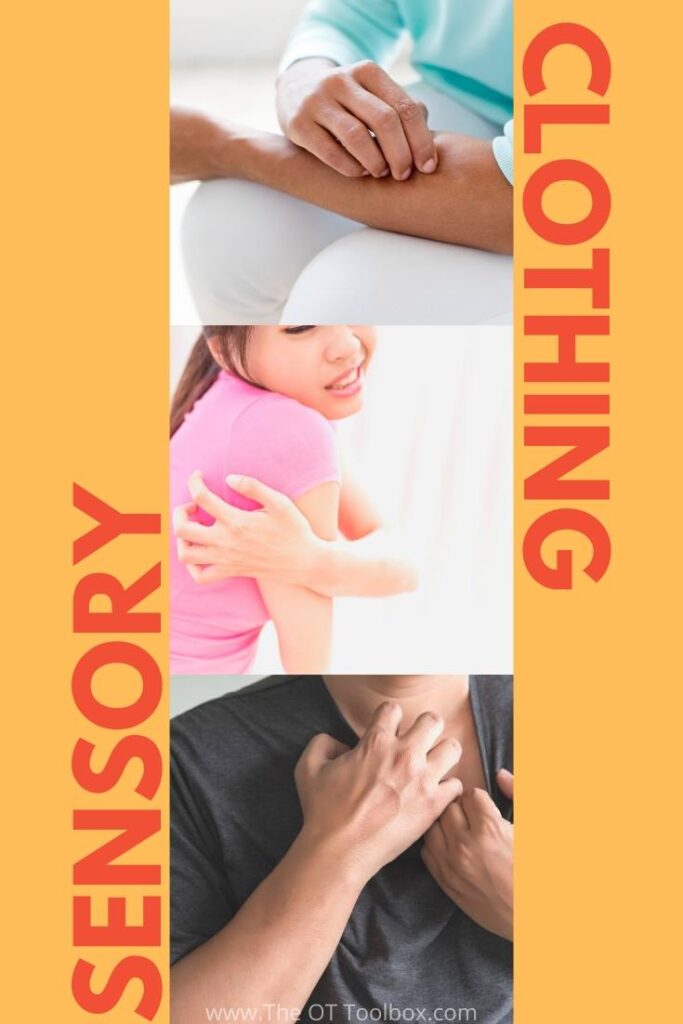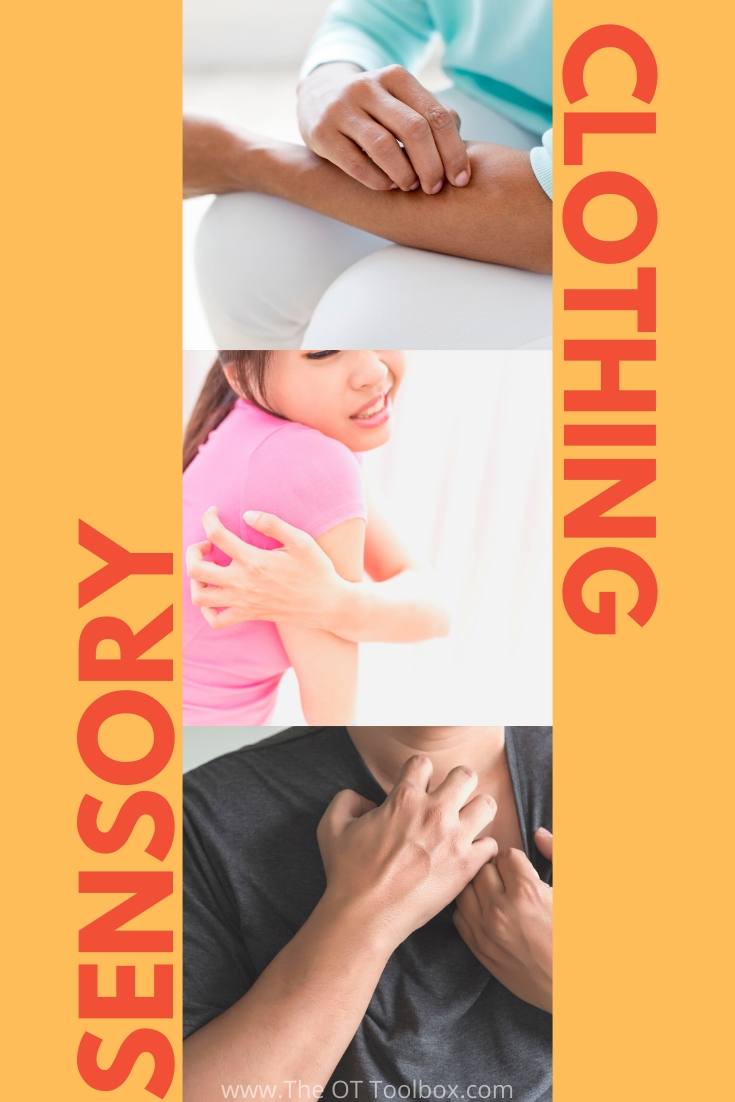Sensory friendly clothing is a must for kids with sensory processing needs. Heck, sometimes that itchy sweater or scratchy jeans get on my nerves, too! Today we are chatting all things sensory friendly clothing. Sensory issues with clothing are a common concern. Even winter sensory clothing issues are something to think about. You’ve probably noticed that itchy tag or a turtle neck sweater that just drives you nuts. But what about our kids with sensory issues?
Sensory friendly clothing
Before we get into the nuts and bolts of sensory friendly clothing, it’s helpful to have a few resources on hand. Read up on our articles on clothing sensitivity red flags, weighted vests and compression garments, as well as clothing fasteners because all of these supports can help.
Finding clothing for sensory issues can be a puzzle and an an adventure! Today we are talking about sensory friendly clothing and how something as simple as sensory friendly pajamas can make a world of difference in the child with sensory processing disorder or sensory needs.

Sensory Clothing
Many times, our kids with sensory processing needs struggle with tactile defensiveness or sensitivities when it comes to clothing. It’s nothing new to find that certain materials, seems, or clothing articles are itchy, scratchy, bumpy, rough, or even hurt our kids. Parents of children with sensory needs find that addressing sensory clothing issues is a real struggle. It’s just one more aspect of daily life that needs adjusted, modified, or adapted.
Meeting the needs of the child is essential for function and self-care. In fact, that independent functioning at the “just right” level is the foundation to daily life. Self-care is a priority of parents and allows children to become more self-reliant (Chiarello, 2015). It builds skills, develops self-awareness and self–esteem. Self care by identifying and understanding one’s particular preferences and using those day in and day out in self-care tasks brings us full circle in the way of functioning.
While there are ways to adapt clothing to make it less of a tactile issue, and addressing sensory sensitivities through sensory diets and sensory input is helpful, sometimes, meeting the child’s specific needs makes sense in the way of adaptive clothing that meets the needs of the child.
Sensory Clothes on the Market
Luckily, we are in an age of more awareness and inclusion. We have seen more and more sensory friendly clothes on the market and readily available in stores. We are able to use what is out there, and when the specific adaptive clothing is not available, we can sometimes adjust what we’ve got to make it meet the child’s needs.
You may have seen sensory clothing available in stores and online. The fact is that these items are more readily available. And, that is a wonderful thing to see! Prices, styles, and selection are improving. Costs are becoming more affordable. Our children with sensory needs can better thrive as a result.
Sensory Clothing Issues
There are certain aspects of clothing that are a common complaint for those with sensory processing issues impacted by clothing sensitivities. Some common complaints include:
- Annoying Seams on clothing
- Bumps or wrinkles in fabric
- Tags that itch and scratch
- Rough material
- Clothing that bunches
- Clothing that doesn’t “give” or stretch
- Wide leg or arm openings that “flap” around the wrists or ankles
- Clothing that is too tight or too loose
- Pressure from shoes or footwear that doesn’t bend or give
- Elastic waistbands
- Padding or underwire in bras
- Shoulder straps that are tight or too loose
- Clothing that doesn’t breath or holds moisture from sweat
- Clothing that never seems to fit “just right”
All of these concerns are sources for a daily battle when it comes to getting dressed and with the end result of independent self-care and self-dressing for kids. Getting out the door and onto the school bus can be a daily struggle that leads to a meltdown before the day even begins.
The same situation can occur at night when children with sensory processing disorder are asked to get dressed into their pajamas…those itchy pjs that bunch and pull…it’s a nightly battle that results in a pre-bedtime meltdown and hours of restlessness when what the kiddo and parents really need are rest and sleep.
Sleep and sensory needs
Occupational therapy practitioners often support and work with families of children with an autism spectrum disorder or another developmental disorder to address function as it relates to effective sleep. Sleep deprivation can impact the child, the family, and functional abilities on a day-to-day basis. When a child with sensory processing needs struggles to find rest as a result of clothing issues, meltdowns at bedtime, or frequent waking as a result of sensory avoiding or sensory seeking behaviors, sleep is impacted.
OT professionals aim to address a variety of needs impacting restful and adequate sleep. One such strategy for sensory needs is to suggest sensory friendly pajamas and clothing (Picard, 2017).
Want to try a pair of sensory friendly pajamas to address sensory issues like the one discussed today? Let’s take things up a notch by getting a sensory clothing into your hands.
One sensory clothing company that really addresses the sleep and sensory component is Lovey & Grink. These sensory friendly pajamas are fun and comfortable pajamas that they are excited to put on before bed. So often, kids complain that pjs are hot or scratchy. It can result in a nightly meltdown.
Take a look at many of the sensory pajamas out there on the market. When you look for super soft pajamas, you might notice that most of the softer pajama brands we saw were prone to shrink or really expensive. Lovey & Grink pajamas are kid tested and approved and best of all, reasonably priced. A bit more about these sensory pajamas”
- Breathable (keeping your kids cool)
- Durable (they’ll hold their shape and last after tons of washing)
- And super soft (they’ll want to live in them!)
Parents know that anything that makes the bedtime routine a little smoother is a welcome help. These sensory friendly sleepwear is a tool that meets the child’s needs for better sleep.
Sensory Pajamas Giveaway
This giveaway has now ended.
Some of the smartest and most creative folks I know are the readers of The OT Toolbox. I asked readers to tell me sensory strategies they personally love and use to address sensory modulation. Scroll through the comments…you might just find some new sensory strategies that will work for you! Hopefully we can learn from one another!
Also, check out these other soy suggestions based on therapeutic development through play.
- Fine Motor Toys
- Gross Motor Toys
- Pencil Grasp Toys
- Toys for Reluctant Writers
- Toys for Spatial Awareness
- Toys for Visual Tracking
- Toys for Sensory Play
- Bilateral Coordination Toys
- Games for Executive Functioning Skills
- Toys and Tools to Improve Visual Perception
- Toys to Help with Scissors Skills
- Toys for Attention and Focus
References:
Lisa Chiarello and the Move and Play Study Team (2016) Children’s Participation in Self-Care and Ease of Care-giving for Parents. Movement and Participation in Life Activities of Young Children Information for Families and Service Providers. www.canchild.ca.
Picard, M. (2017). American Occupational Therapy Association Fact Sheet. Occupational Therapy’s Role in Sleep. Retrieved from https://www.aota.org/~/media/Corporate/Files/AboutOT/Professionals/WhatIsOT/HW/Facts/Sleep-fact-sheet.pdf



